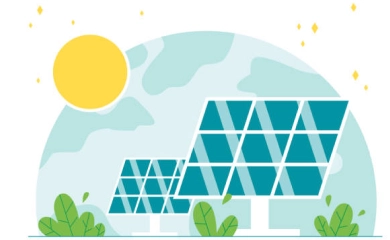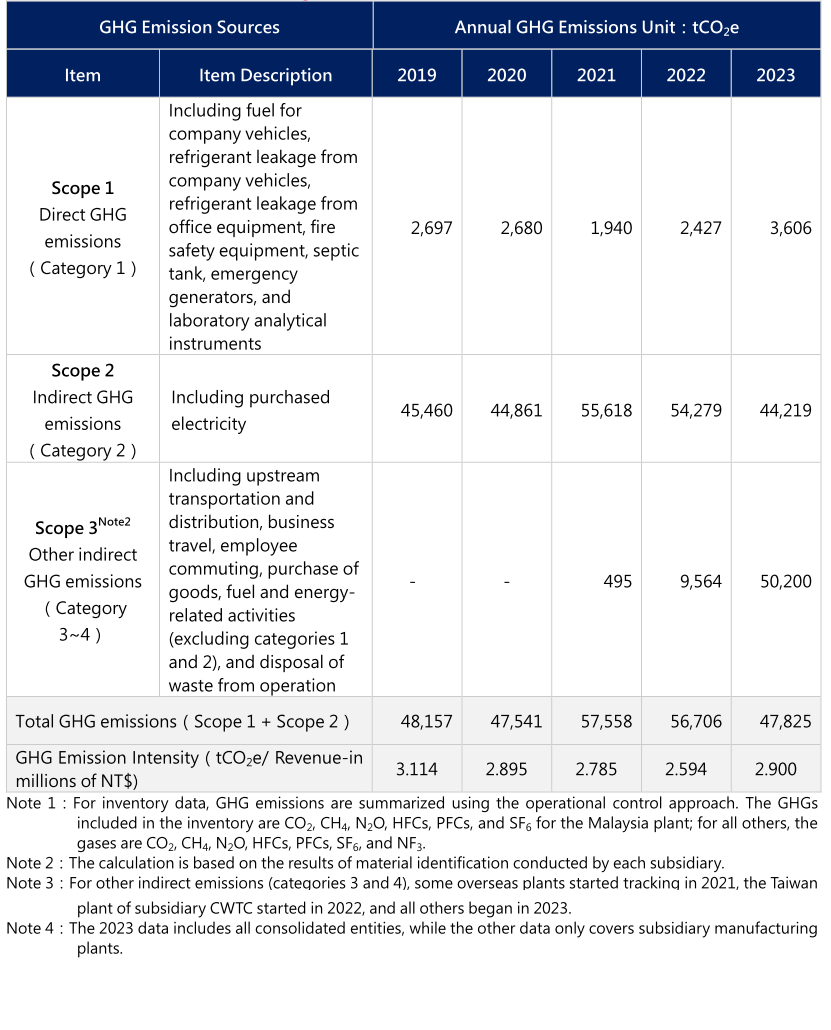
Corporate Sustainability
ENVIRONMENT
Energy Management
To respond to the challenges of global energy shortages and climate change, subsidiary CWTC consolidate energy-saving proposals from all units to set relevant targets and action plans each year and periodically monitors and controls performance. Additionally, we promote production machinery assessments to drive energy efficiency improvements in plant facilities.
Based on subsidiary CWTC's energy-saving plan submitted to the Bureau of Energy, Ministry of Economic Affairs, the average energy-saving rate approved for subsidiary CWTC's Taiwan Plant 2 was 2.97% in 2023. In line with the government's promotion of renewable energy, subsidiary CWTC increased the installed capacity of solar panels at our Taiwan plant in 2020, reaching a cumulative capacity of 107 kWp by 2023, generating 119,877 kWh. Subsidiary CWTC's new Taiwan plant, scheduled to commence production in 2024, will add an additional installed capacity of 126 kWp, bringing our total solar panel capacity to 233 kWp.
CWE actively supports the government's renewable energy policies and adopts green electricity. In 2024, the Company purchased a Renewable Energy Certificate for NT$2,000, expecting a saving of 1,000 kWh of electricity. According to the 2023 electricity carbon emission factor of 0.494 kg CO2/kWh published by the Bureau of Energy, this initiative is estimated to reduce carbon emissions by approximately 0.494 metric tons.

※Energy Consumption
| Unit:GJ | Year | ||||
|---|---|---|---|---|---|
| Item | 2020 | 2021 | 2022 | 2023 | |
| Direct Energy | Diesel fuel | 251 | 276 | 1,174 | 365 |
| Gasoline | 733 | 361 | 500 | 656 | |
| Natural gas | 18,463 | 18,463 | 22,673 | 17,110 | |
| Indirect Enengy |
Purchased electricity |
248,225 | 268,055 | 279,597 | 275,936 |
| Renewable energy | 23,977 | 26,662 | 20,884 | 17,287 | |
| Total | 291,649 | 317,469 | 324,828 | 311,354 | |
Note 1:Conversions are based on the “Heat Content of Energy Products” of the Ministry of Economic Affairs.
Note 2:Renewable energy mainly includes solar energy and non-pumped storage hydroelectric power. Solar energy is estimated annually based on the daily generation in GJ of the installed capacity. Non-pumped storage is estimated based on the actual electricity consumption in the locality, with proportions determined for wet, normal, and dry periods.
Note 3:The 2023 data includes all consolidated entities, while data for other years covers only the manufacturing plants of subsidiaries.
※Electricity Usage
In 2023, the total electricity consumption reached 76,648,870 kWh(76,649MWp), with an electricity intensity of 4.65. The largest source of electricity consumption was process power, accounting for 55% of the total, followed by air conditioning, which accounted for 26% of the total electricity consumption. Although the total electricity consumption in 2023 decreased compared to 2022, the intensity increased, mainly due to the testing requirements of Subsidiary CWTC's new plant in Taiwan. Going forward, we will continue to focus on energy efficiency, renewable energy use, and alternative energy planning and execution.
| Year | 2019 | 2020 | 2021 | 2022 | 2023 |
|---|---|---|---|---|---|
|
Electricity consumption (Unit:MWH) |
69,284 | 68,591 | 74,460 | 77,666 | 76,649 |
|
Intensity (MWH/Revenue-in millions of NT$) |
4.48 | 4.20 | 3.60 | 3.55 | 4.65 |
Note:The 2023 data includes all consolidated entities, while data for other years covers only the manufacturing plants of subsidiaries.
※Energy-saving Measures
To effectively lower energy consumption and GHG emissions, we actively promote various energy-saving measures. The focus is on improving the energy efficiency of plant facilities and production equipment, optimizing operational efficiency by adjusting production equipment parameters, and replacing traditional lighting with energy-efficient alternatives. We aim to achieve our environmental and energy-saving goals through initiatives across its plants. Additionally, we raise energy-saving awareness by encouraging employees to turn off lights when not in use and shut down computers after work. We also promote the widespread use of energy-efficient lighting and installs motion-sensor switches in areas with intermittent lighting needs to reduce energy waste by changing daily habits.

Energy-saving Measures and Performance of Each Plant in 2023
| Plant | Measures and Performance |
|---|---|
| Taiwan Pant1 | Chiller replacement achieved annual energy savings of 416,976 kWh (equivalent to 1,501 GJ). |
| Taiwan Pant2 | Air compressor replacement achieved annual energy savings of 719,268 kWh (equivalent to 2,589 GJ). |
| Suzhou Plant | Adjusting the frequency of the air conditioning fans, turning off the humidifier outside of winter, and shutting down power-consuming equipment during holidays achieves annual energy savings of 3,278 MWh (equivalent to 11,801 GJ). |
| Malaysia Plant | Replacing traditional fluorescent lamps with LED lamps, installing solar streetlights, and replacing turbo air compressors achieved annual energy savings of 1,083,660 kWh (equivalent to 3,901 GJ). |
| Toral | 19,792 GJ |
Key Points of Energy-saving Programs
| Programs | Taiwan Plant | China Plant | Overseas Plant |
|---|---|---|---|
| Parameter setting | ★ | ★ | ★ |
| Production process integration | ★ | --- | ★ |
| Equipment process integration | ★ | ★ | --- |
| Energy-saving of facilities | ★ | ★ | ★ |
Progressive Energy-saving Plans
| Stage | Measures |
|---|---|
| Short-term |
|
|
Medium-and Long-term |
|
※GHG Emissions Management
To fulfill our social responsibility, CWE Group voluntarily conduct an annual self-assessment and disclosure of our GHG emissions. Except for the subsidiary CWEC, which has not yet obtained external verification, CWE Group's other consolidated entities have completed the external assurance of GHG inventory in 2023. As purchased electricity is the main source of GHG emissions, we analyze the electricity consumption of our plant equipment and strive to reduce energy loss and improve energy efficiency.
GHG Emission Inventory

We adopted external inventory under ISO14064-1:2018 for the first time at our Taiwan plant of subsidiary CWTC in 2022, while other sites implemented it in 2023. The Taiwan plant calculated its GHG emissions using the “EPA GHG Emissions Factor Management Table (v. 6.0.4),” published by Taiwan's Ministry of Environment. For China, emissions were calculated using the "2006 IPCC Guidelines for National Greenhouse Gas Inventories," the "China Products Carbon Footprint Factors Database," the "2022 National Grid Emission Factor" issued by the Ministry of Ecology and Environment of the PRC, the " China Products Carbon Footprint Factors Database (2022)," the "ecoinvent database," and the "2023 GHG Emission Factors Hub." For Malaysia, emissions were calculated using the "Greenhouse Gas Reporting: Conversion Factors 2023," published by the UK Department for Environment, Food and Rural Affairs (Defra), and the grid emission factors published by the Malaysian Energy Commission. For Singapore, emissions were calculated using the grid emission factors published by the Singapore Energy Market Authority. The global warming potential (GWP) for the Group was calculated using the "IPCC AR-6."